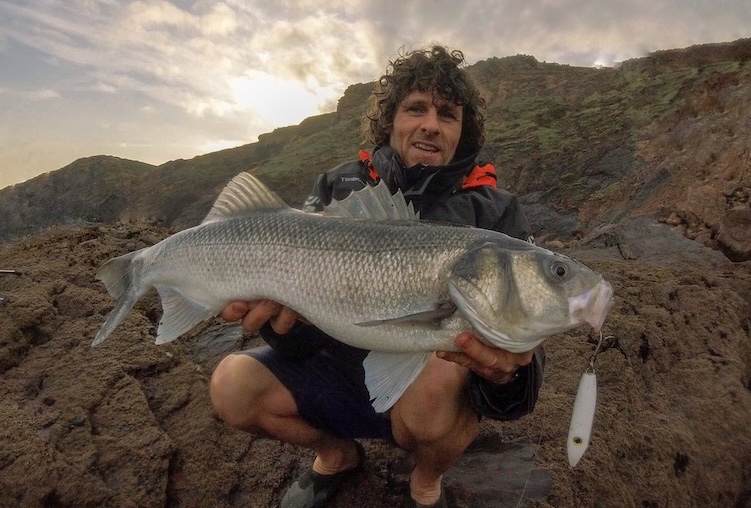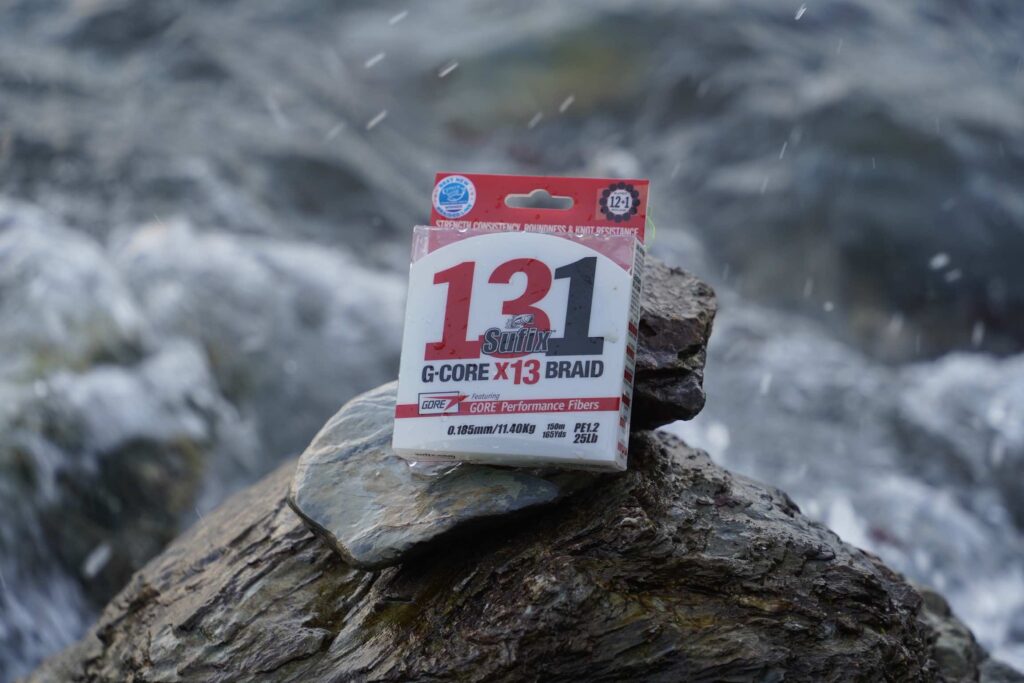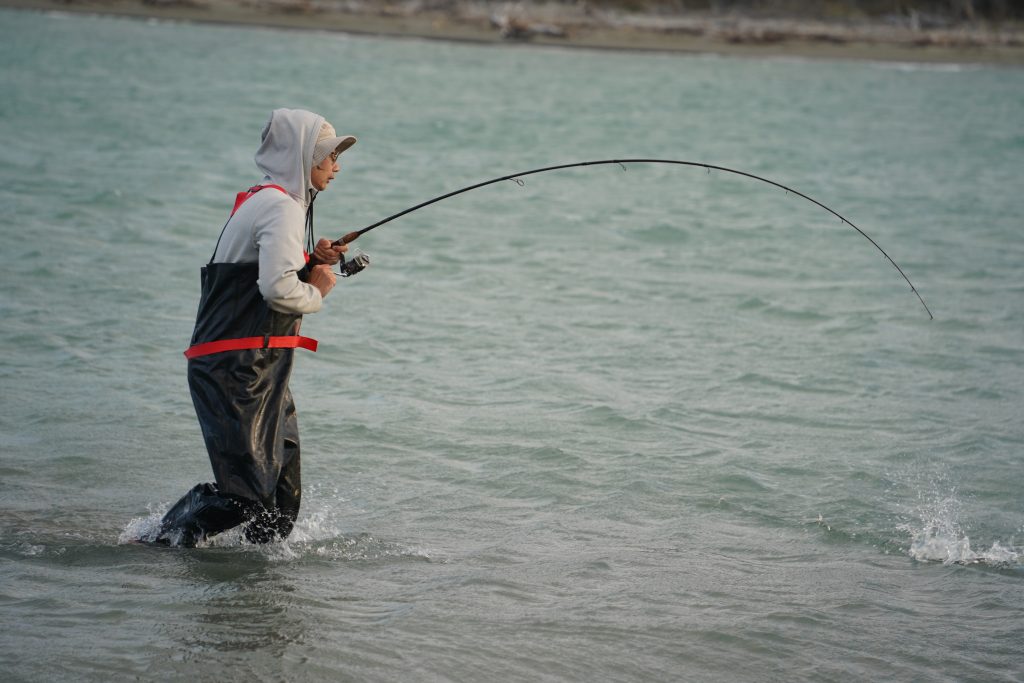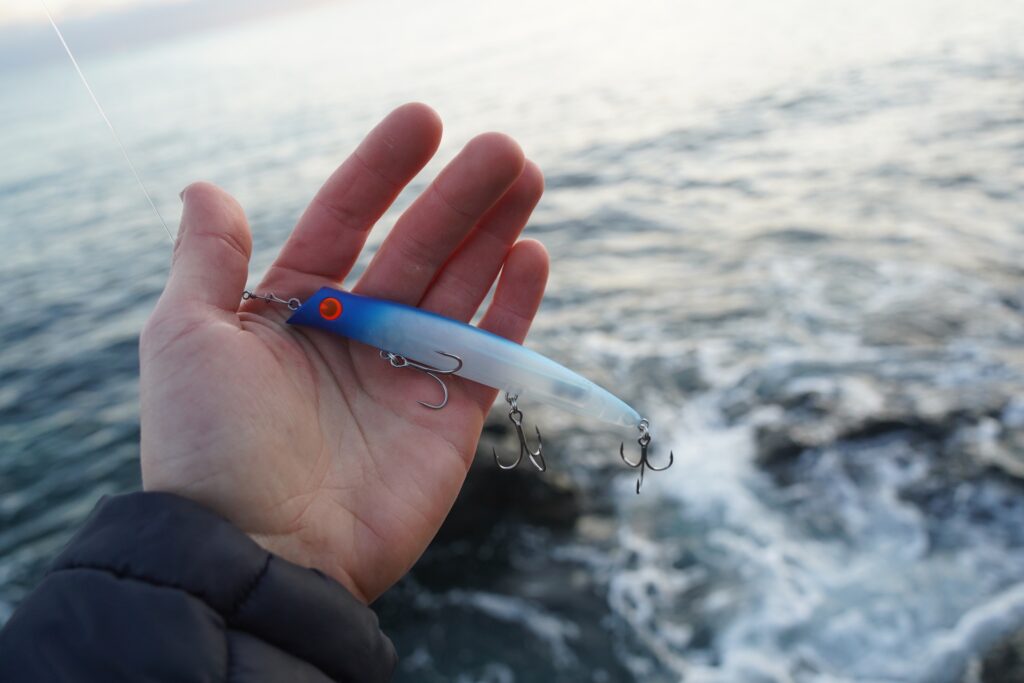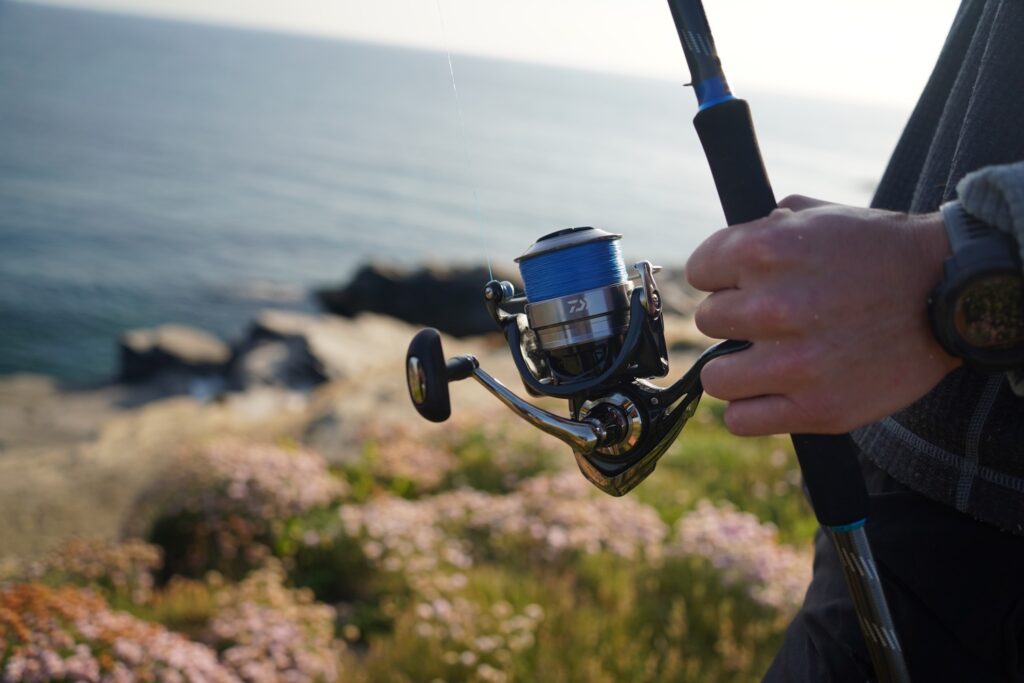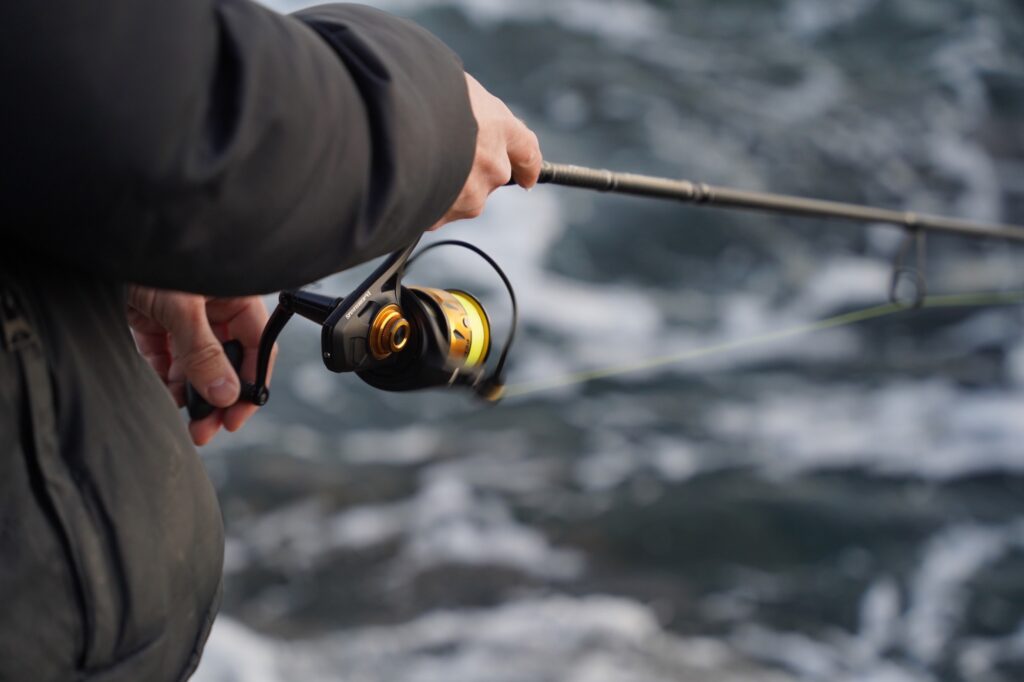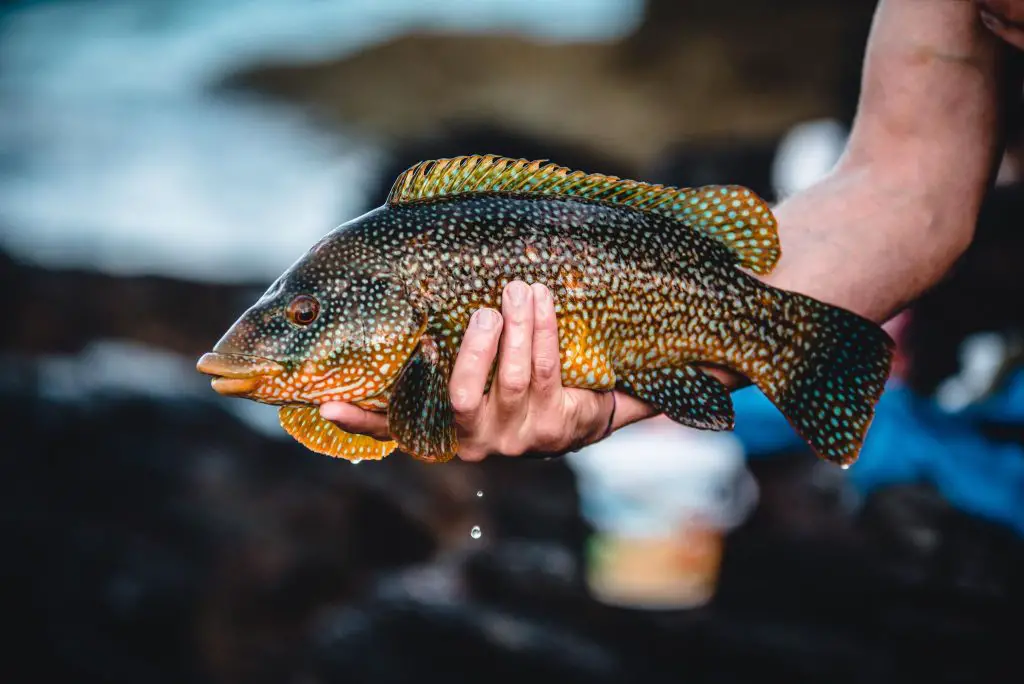
Photo Credit to Matilda Björklund
Wrasse fishing
Wrasse fishing is some of the most fun you can have while rock fishing in the UK. When the bass aren’t playing ball, a ballan wrasse is sure to smash your lure instead. Simply fish with a spinning rod, use a Texas rig with a weedless hook and you’re away. If you haven’t tried this before, trust me it’s not complicated! Let’s take a closer look. We’ll also look at the float fishing and bottom fishing methods for catching wrasse on bait, as well as looking at other UK wrasse species for LRF anglers.
Fishmag is reader-supported and earns commissions from affiliate sales, such as from amazon.
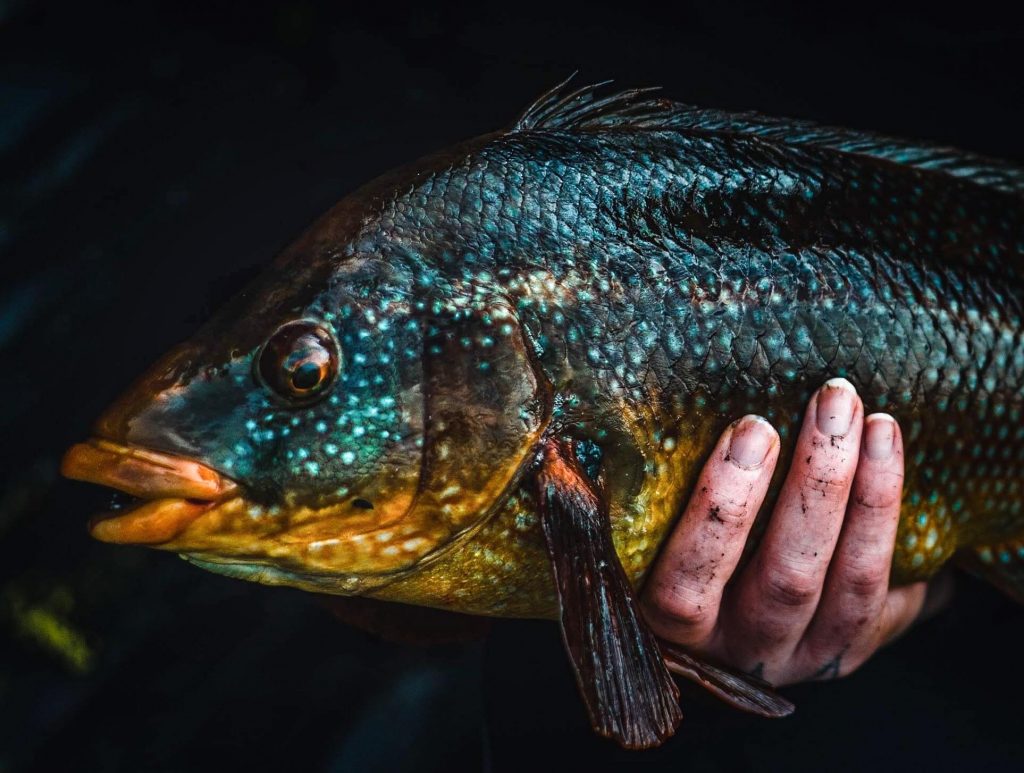
Photo Credit to Matilda Björklund
Ballan wrasse are highly abundant in clear waters throughout the UK, due to having no commercial value except to salmon farms. These fish live in rough ground, amongst heavy kelp and boulders. When they take a hook, they will immediately crash into the kelp, where about 50% of the time your line will get wrapped up in weed. This is frustrating for you and likely game over for the fish. Really not great. That’s why as soon as you feel the fish, you have to lift the rod tip high and ‘pump’ the fish up, turning your reel as fast as you can. LRF rods are not suitable for ballan wrasse fishing over rough ground because you can’t stop a crash dive (even though a lot of the time you can still land them).
Wrasse fishing with lures set up
Size 1/0 STRONG weedless hooks, crush the barbs for quick release
Cone weights, shinier is better
Fluorocarbon leader, for abrasion resistance with braid
Disgorgers, essential for unhooking wrasse
Then simply grab one of our recommended lure fishing set ups with a maximum casting weight of around 30-40g.
If you go lighter than this, you will lose fish and tackle. If you go heavier, you won’t be able to cast a 7g worm weight effectively. It’s also important to know how to tie a good braid to fluorocarbon leader knot if possible so that you can use braid, as this will allow you to still cast a 10g lure a good distance. If you’re using mono, you may need to use a 20g worm weight and fish a larger soft plastic, which will mean you are only effectively targeting larger wrasse (filtering out perhaps 90% of them).
Best Wrasse Lures
Wrasse hit a wide variety of lure types and are not hugely fussy most of the time – they are common bycatch when jigging or even mackerel feathering. Straight tails are most practical because they’re harder for wrasse to bite through than paddle tails and more likely to result in hook ups than curly tails which invite tail bites. Basically, anything with a tail is going to cause tail bites. When it comes to colour, orange, purple, green – kelp colours – are often favoured. You don’t often see people using colours like pink or white for the wrasse, and we tend to go with that…
The senko
As mentioned above, a weedless rigged senko is the simplest and cheapest approach to wrasse fishing. These lures are cast out and left on the bottom, with occasional twitches to lift them a 1-6ft up off the bottom, before allowing them to drop back down again. Wrasse will hit them even when not moving. The lure can also be retrieved at higher speed for bass, although the colours used for wrasse fishing tend to be greens, purples and blues whereas for bass most would reach for white or silver.
A shorter senko can increase hook ups as there will be fewer tail nips.

Fiish Black Minnow
I would not recommend using a Fiish Black Minnow for wrasse for most people because it’s so costly – wrasse will bite off the tails and these lures aren’t cheap. However, if you want to primarily catch bass but want to catch wrasse while you wait for them, this is a good choice because it’s weedless so you can fish it through the kelp, unlike a lot of other bass lures. It kills far more than two birds with one stone, this lure…
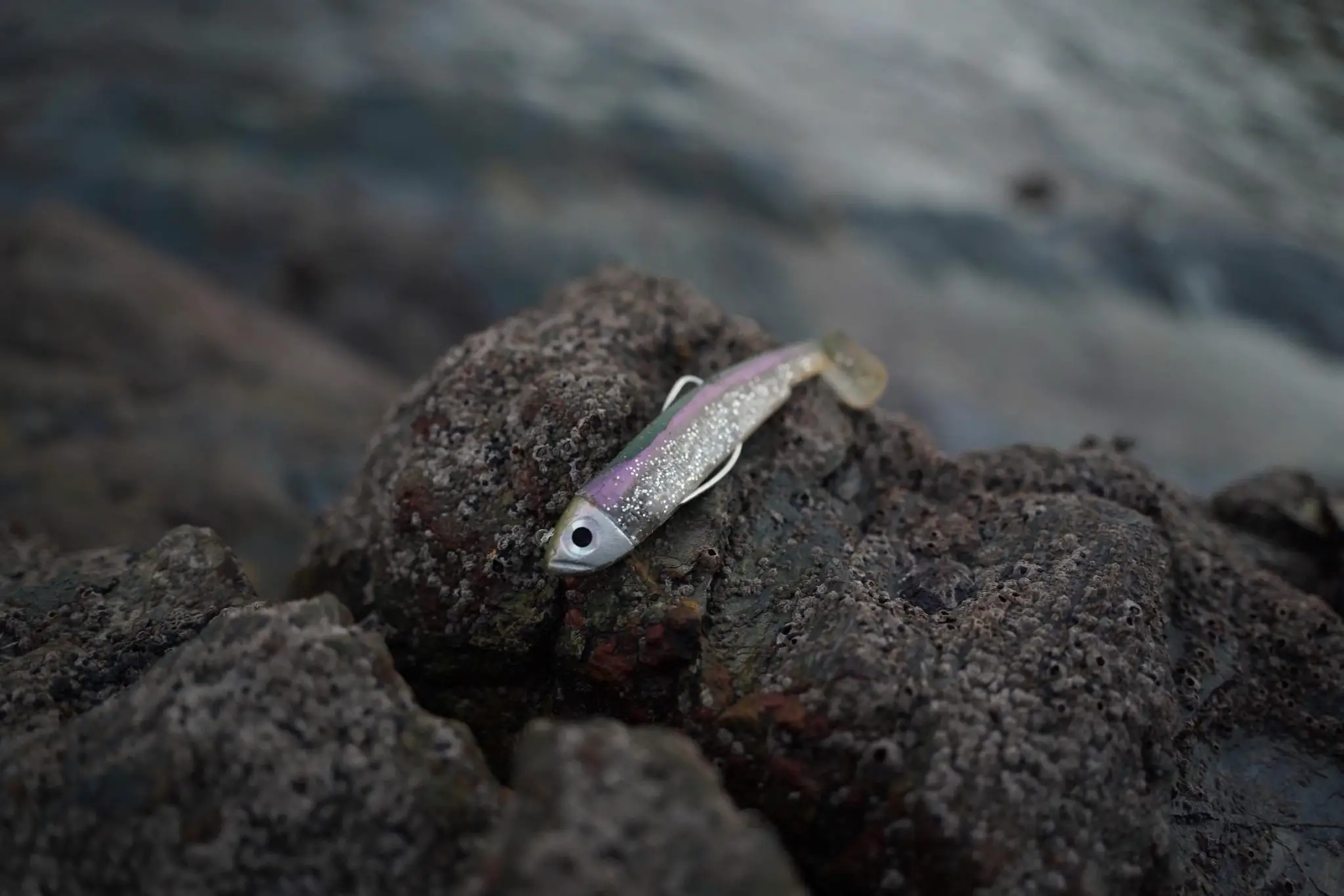
X Layer
Now considered a bit of an old school classic in wrasse fishing, the Megabass X Layer is probably the most effective lure for these fish. That’s because it comes with a rattle which makes extra noise, and as we’ll discuss in more depth later, wrasse hit lures partly because they’re p*ssed off with life, so the rattle helps get their attention. They aren’t cheap though compared to senkos.

Other wrasse lures
If you’re using LRF gear and targeting smaller wrasse, we’ve had a lot of success with 2″ straight tail lures on smaller weedless hooks. Creature baits are also good fun to play about with. Weighted creature baits can be fished completely weedless waitless for an impeccable finesse presentation. Perhaps overkill for the wrasse, but suspicious bass may favour the absence of a cone weight.
Slight variations on the ‘straight lure’ theme are interesting. Especially if there isn’t a thin section that can easily be bitten through. He’s a good example from Z Man.
How to catch wrasse on lures
Lure fishing for Wrasse has become immensely popular since Japanese fishing rods that cast about 28g became popular in the UK. It’s still a fairly fringe pursuit as of 2024 compared to bait fishing, but this approach is highly, highly effective. There’s only one simple rig that’s commonly used for this style of fishing, and that’s a weedless hook with a straight tail soft plastic and a small lead weight designed for weedless hooks directly above it. These lures don’t snag much at all if rigged cautiously and get your lure right amongst the kelp. Wrasse hate them, and hit them hard, every time. If using this method, given how tough the mouths of Wrasse are, it’s crazy not to use weedless hooks if you can.

Photo Credit to Matilda Björklund
The fish gradually change colour to match their environment, with fish ranging from bright red to dark brown, yellow and vibrant green. They are hermaphrodites, and begin life as females before becoming male after reaching a certain size. Male fish are territorial and unlike bass, pollack and other species, tend to stick around one area which is their territory. The fish have large, goofy teeth that can take barnacles and limpets from rocks.
There’s some debate as to why wrasse hit lures. Some claim they hit the lures out of territorial aggression. The evidence for this is that the fish will strike lures that they have no chance of ever getting into their mouths, including large bass plugs. The alternative theory is that wrasse are actually more predatory than they seem when you watch them cruising around the kelp while snorkelling, and actively hunt small fish. I know of spear fishermen that have seen wrasse chasing and feeding on sand eel, and smaller wrasse also hit lures, despite having no reason to be territorial since they aren’t males defending an area. Therefore, I believe the wrasse to be a predator, even though it mostly eats limpets!
Float fishing for Wrasse
A better method for bait fishing for these fish would be to use a float so that you can suspend your bait just above the kelp. Fishing a ragworm 1m above the kelp anywhere in Cornwall where I live and you’re guaranteed to catch a wrasse on a clear day unless you’re really unlucky. Any time of year is fine, as long as the ground is really rough. It’s quite common for new anglers to try to fish only in areas where they won’t get snags, but this is not a good method for catching wrasse or a great many other species!
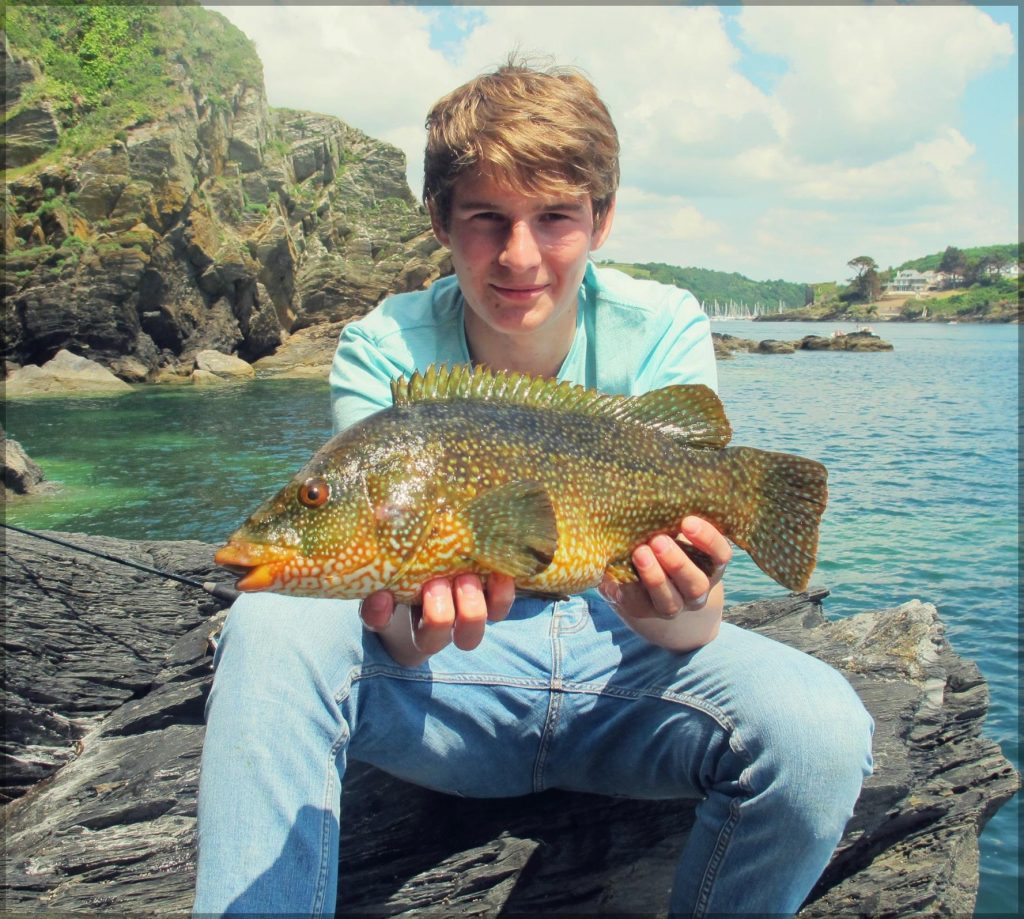
Bottom fishing for Wrasse with bait
If you’re bait fishing, you will catch these fish by bottom fishing just on the edge of an area of rough ground, by casting onto sandy ground – snag-free – to tempt the wrasse in the kelp to come out. There is no bait that compares to the ragworm for catching wrasse. Lugworm is good, sandeel will work – but ragworm just turns these fish on. You can also fish directly down the side of harbour walls, and this is 100% the best place to be fishing if you are on a harbour. Don’t bother casting out, you’re casting over all the fish!
In the Isles of Scilly – where all the monster fish seem to live – Wrasse can sometimes grow to over 10lb. A very big fish is 5lb, and a nice Wrasse is 3lb.

Where to catch them
Wrasse live in kelp – right in the thick of it. If you go snorkelling on a clear day you’ll see them, sitting or slowly swimming through dense brown kelp beds. The first place you should cast upon arriving at a rock mark is directly at your feet. The wrasse pictured below was caught first cast 5m out. These fish often hug boulders and the very rocks you’re stood on – perhaps for protection from seals – but also because they feed on the shrimp and limpets that cling to rock faces.
You’ll also catch Wrasse on wrecks offshore – these fish are never far from the structure. Lure anglers suddenly catch a lot of these fish once they start regularly using weedless hooks, as you need your lure to literally be in the kelp, falling into the cracks and gullies, to catch these fish. They are also occasionally caught by unsuspecting anglers on mackerel feathers, plugs and spoons – these fish are not fussy eaters.

UK Wrasse Species Guide
Wrasse are part of a huge family with an incredible diversity of species. Even in the UK we have Corkwing, Goldsinney, Rockcook, Cuckoo Wrasse as well as the much larger ballans. Large corkwing wrasse are often mistaken for ballans, because they don’t always have a black spot on their tails, which is the most common ID method.
In my estimation, these fish are Britain’s most underrated species. They are around all year in good numbers, they fight much harder than bass or any other predators and are more challenging to land, and they come in a variety of extraordinary colours. It’s a good job too that they taste disgusting, or there wouldn’t be so many of them.
There are eight species of Wrasse in British waters, though I have only ever seen five of these caught and two of them are extremely uncommon catches. We’ve looked at ballans already, so below are the smaller species of the family, which are typically caught as bycatch or else targeted by specialist light game species hunters with LRF tackle.
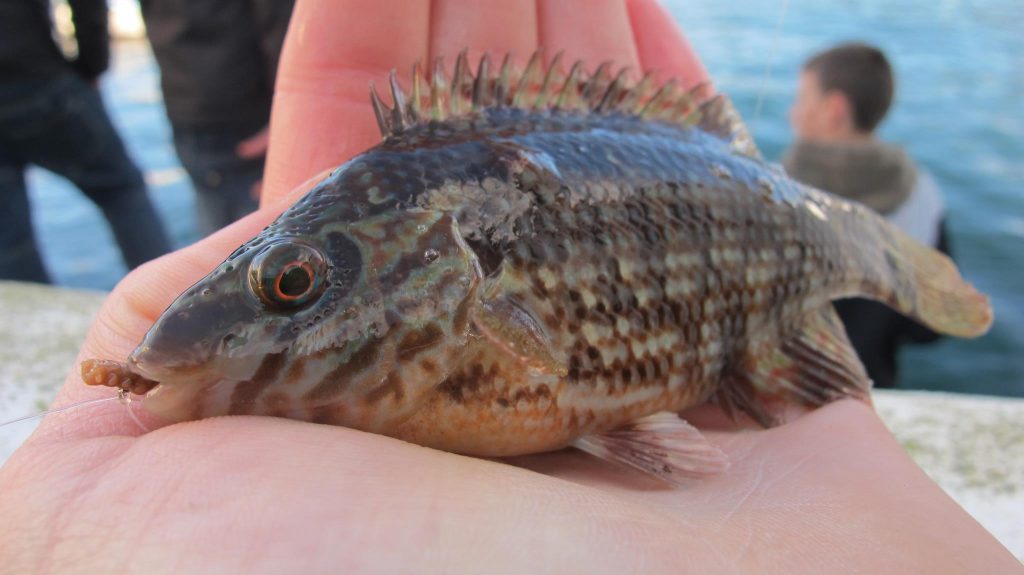
Corkwing Wrasse
These fish are dark and mottled, with more rounded bodies than the Ballan Wrasse with which they are often confused. They don’t grow very large, but can get big enough to seem convincingly like a small Ballan – and they fight just as hard for their size. Often, they have a black spot just before their tail, which gives the fish away. However, this spot is often not present or doesn’t contrast enough with the fish’s mottled, orangey-brown speckled appearance to be visible.
These fish love to eat small ragworms rigged on size 8 hooks, or else a worm imitation lure such as this one on Amazon, which is almost equally effective, and much cheaper. Fish directly down the side of the harbour wall or else directly off the rock face, don’t bother casting out to catch these fish.
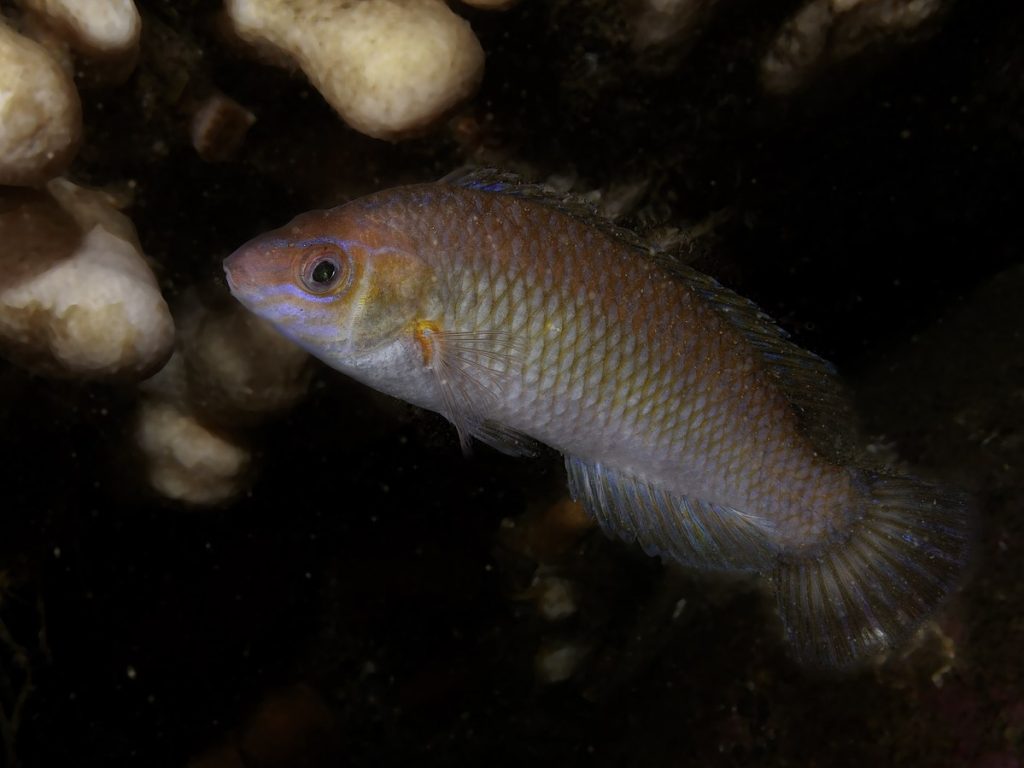
Rock Cook Wrasse
The Rock Cook looks much like a Corkwing Wrasse, but with vibrant, neon blue marking all down its back. This fish is very rarely caught and is far, far rarer than the Corkwing Wrasse. I’ve only heard of these fish being caught in remote rock marks but anglers using LRF gear and worm imitation lure.
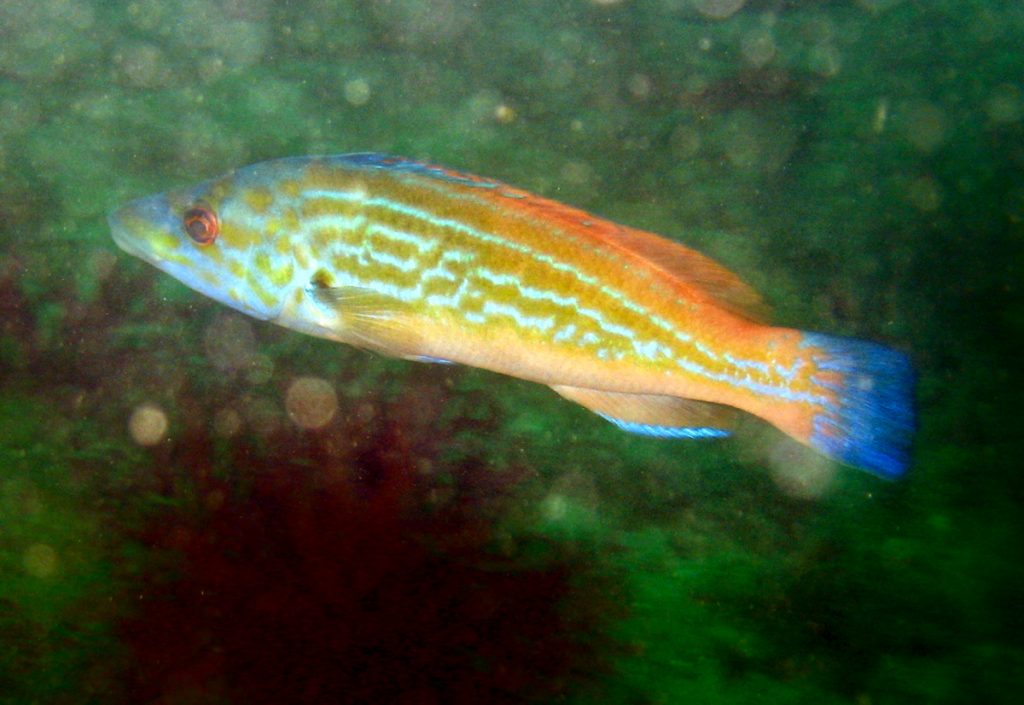
Cuckoo Wrasse
This is the most glamorous fish in British waters, with its vibrant orange and turquoise colours, and more understated red markings on the females. They win the exotic beauty contest every time, though some of the Ballans do try and the Rock Cook makes a good effort…
Cuckoo Wrasse are a species only really caught by boat anglers in the South, or else at rock marks with steep drop-offs into very deep water. They hit lures on rare occasion, though modern HRF tactics are effective for them. Ragworm fished on or near the bottom and around wrecks are the most effective way to target these fish, which are only really caught as bycatch because they’re uncommon enough that actively targeting them could be frustrating for all but the most patient.
The Cuckoo Wrasse’s vibrant appearance makes it look like somebody spilt a watercolour pallet on a fish. Most people wouldn’t believe these exotic-looking fish are common in British waters.
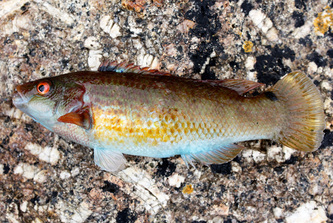
Goldsinney Wrasse
These fish are more elongated and slender than the other British Wrasse species and are the smallest of them all. They also have a black spot on their tails, but unlike the Corkwing’s it is on the top of the tail rather than the middle. They are also characteristically golden in colour.
They are even more aggressive than the other Wrasse in my opinion, or maybe it’s just the way their teeth are more visible than in the other species… These fish are caught as bycatch while fishing with small size 8 hooks with rag worm, or else actively targeted with LRF gear and worm imitations. Shrimp would be very effective for this species since they likely depend on them for much of their diet.
There aren’t many of these left in Cornwall now that they are actively targeted for use in Scottish salmon fisheries. These fish used to be abundant around harbour walls but then disappeared, along with the Corkwings.
Scale-rayed Wrasse
If you see this fish in your lifetime, you are a lucky person indeed. Even hardcore species hunters don’t really ever catch these. These fish have yellow spots that run all the way along the back, and grow up to 25cm, making them more likely to be confused with a Cuckoo wrasse than the other species.
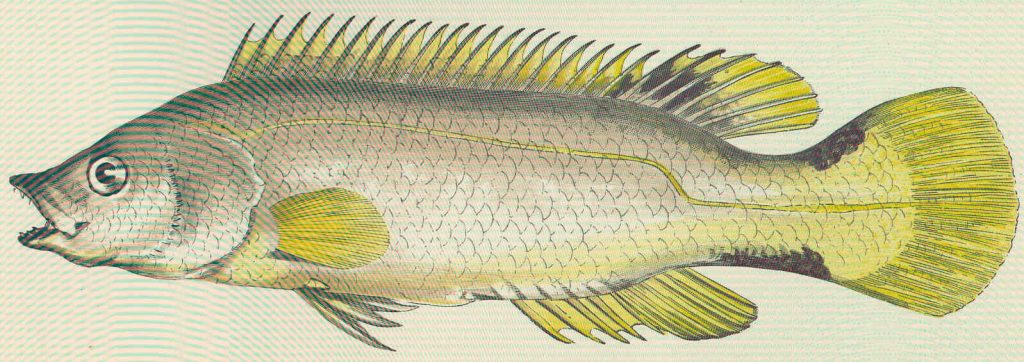
Rainbow Wrasse (not another name for the Cuckoo, but a different species)
These are easy to catch in the Mediterranean but extremely rare in the UK as of 2021. They are very long and slender, and fish caught in the UK must feel lost indeed.
Ballion’s Wrasse
Similar to the Corkwing but much rarer, these fish have pinkish lips and a longer face. I have only heard of these fish being caught in Weymouth, and they are a very rare catch even with LRF gear and Marukyu Isome.
Wrasse and their teeth…
Wrasse eat barnacles, crustaceans and worms. In school, they would be the kid with the big goofy teeth – and indeed they are spectacularly geeky looking when their lips are gently lifted to reveal their nashers. These are fish which can bite through barnacle shells and have more grinding teeth in the backs of their throats (called ‘pharyngeal’) for dealing with all that hard calcium carbonate in the various shells they feast on. I’ve never been bitten, unlike by the Common Blenny or Tompot Blenny, which have very sharp teeth for the same purpose and often draw the blood of unsuspecting anglers.
Given how stupid these fish seem when they smash into plugs and spinners far too large for their mouths, it’s impressive that these fish make nests using their own mucus and seaweed, to lay their eggs in. What an extraordinary family of fish.
A huge thank you to Matilda Björklund for her amazing photos towards the top of this page.
Surf fishing for big bass | Grant Woodgate
Surf fishing for big bass with Samson Lures | Masterclass with Grant Woodgate Few people…
The best braided fishing lines, ranked
The best braided fishing lines, ranked We look at the best braids, from the budget…
The best bass rods | Finding your next stick
The best bass rods | Finding your next stick The most common bass fishing setup…
The UK’s Best Bass Lures
The UK’s Best Bass Lures Let’s start by looking at the three bass lures that…
The Ideal Lure Fishing Set-Up
Lure fishing set ups, everything you need. In this article, I will recommend specific rods,…
Rock Fishing with Lures
Rock Fishing with Lures You’re sat, perching on a rock below a colony of cormorants….

